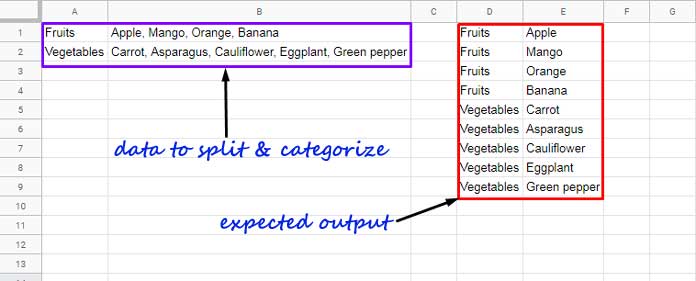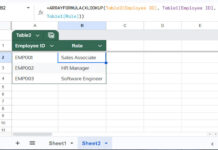It’s common to come across comma-separated lists that need to be organized and categorized for better readability and analysis. For example, you may have a list of items—like fruits or vegetables—stored as a comma-separated string in one column, with a corresponding category label in another.
To make this data more manageable, you can split values by category in Google Sheets and lay them out into two clean columns: one for the category and one for each individual item.
In this guide, you’ll learn how to split values by category into two columns in Google Sheets, transforming your comma-separated lists into a structured format that’s easier to analyze and filter.
Formula to Split Values by Category into Two Columns in Google Sheets
Here’s a formula that splits text into columns and categorizes the results in Google Sheets:
=LET(
data, ARRAYFORMULA(SPLIT(FLATTEN(cat&"|"&SPLIT(items, ", ", FALSE)), "|")),
SORT(FILTER(data, CHOOSECOLS(data, 2)<>""))
)Replace items with the range containing the comma-separated values, and cat with the corresponding category label range.
Features of This Formula
- ✅ No LAMBDA required — Resource friendly
- ✅ Array formula — processes the entire dataset at once; no need to drag down
- ✅ Sorted output — categories appear in ascending order
- If you want to keep the original row order, replace:
SORT(FILTER(data, CHOOSECOLS(data, 2) <> ""))with:FILTER(data, CHOOSECOLS(data, 2) <> "")
- If you want to keep the original row order, replace:
How to Split and Categorize Comma-Separated Data in Google Sheets
In the example below, column A contains category labels (e.g., Fruits, Vegetables) and column B contains the corresponding comma-separated items.

Split to Column and Categorize Multiple Rows of Values
Paste the following formula in cell D1:
=LET(
data, ARRAYFORMULA(SPLIT(FLATTEN(A1:A&"|"&SPLIT(B1:B, ", ", FALSE)), "|")),
SORT(FILTER(data, CHOOSECOLS(data, 2)<>""))
)Formula Logic Explained
Here’s how the formula works to split values by category in Google Sheets:
SPLIT(B1:B, ", ", FALSE)– splits the comma-separated values using", "as the delimiter.
If your values are just comma-separated (no space), use","instead.A1:A&"|"& ...– combines each category with each corresponding item using a pipe (|) as a delimiter.FLATTEN(...)– flattens the combined results into a single column like this:
Fruits|Apple
Fruits|Mango
Fruits|Orange
Fruits|Banana
Fruits|
Vegetables|Carrot
Vegetables|Asparagus
Vegetables|Cauliflower
Vegetables|Eggplant
Vegetables|Green Pepper
SPLIT(..., "|")– separates each string into two columns: Category and Item.FILTER(data, CHOOSECOLS(data, 2) <> "")– removes any rows where the item column is blank.SORT(...)– sorts the final result by category.
And that’s how you split values by category into two columns in Google Sheets—clean, dynamic, and fully formula-based!
Resources
- Split Your Google Sheet Data into Category-Specific Tables
- How to Split a Number into Digits in Google Sheets
- Split a Column into Multiple N Columns in Google Sheets
- Split Numbers from Text Without Delimiters in Google Sheets
- Split a Text after Every Nth Word in Google Sheets (Using Regex and Split)
- Split and Count Words in Google Sheets (Array Formula)
- Split Comma-Separated Values in a Multi-Column Table in Google Sheets
- Split Text in Google Sheets Without Losing Formatting (Preserve Zeros & Hex)
- Dynamic Formula: Split a Table into Multiple Tables in Google Sheets






















– screenshot URL remove my admin –
with my attempt …
Hi, Federico Finati,
Thanks for the screenshot. I could understand you want the opposite of the problem attended in this tutorial.
Sample data in A1:B
A | B
Item | Category
Fruit | Orange
Fruit | Lemon
Fruit | Banana
Vegetable | Spinach
Vegetable | Cucumber
As per this sample, you can use these formulas.
D2:
=unique(A2:A)E2:
=byrow(unique(A2:A),lambda(r, textjoin(", ",true,filter(B2:B,A2:A=r))))N.B.:- Byrow is a new function. You can find the related tutorial in my Function Guide.
Synthetic and very elegant … I was lost in the query command … Thank you.
Thanks for your feedback.
Fine work, thank you.
I should solve the dual problem (join two categorized columns)
Hi, Federico Finati,
Sorry, I’m in the dark. Please share an example below.
Just what I needed!
You can discard the QUERY() call if you swap around the concatenation inside the regexp replace so the category goes first:
=ArrayFormula(TRIM(split(transpose(split(textjoin("^",1,if(len(B1:B),REGEXREPLACE(","&B1:B,",",","&A1:A&"^"),)),",")),"^")))
Instead of
Apple, Mango, Orange, Banana,
Apple^Fruits, Mango^Fruits, Orange^Fruits, Banana^Fruits,
it’s now
,Apple, Mango, Orange, Banana,Fruits^Apple, Fruits^Mango, Fruits^Orange, Fruits^Banana
Hi, Scott,
Thanks for your valuable feedback!
Best,